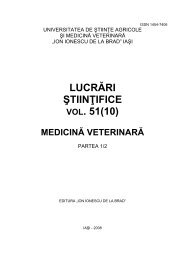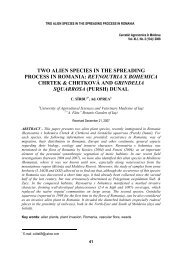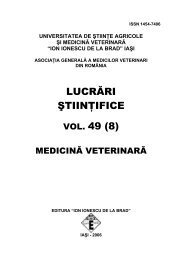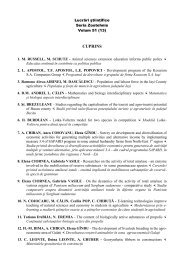biochemical and haematological profile - Universitatea de Ştiinţe ...
biochemical and haematological profile - Universitatea de Ştiinţe ...
biochemical and haematological profile - Universitatea de Ştiinţe ...
You also want an ePaper? Increase the reach of your titles
YUMPU automatically turns print PDFs into web optimized ePapers that Google loves.
KERATOPATHIES IN CARNIVORES: CLINICAL SIGNS AND LOCAL<br />
PATHOLOGIC RESPONSES<br />
IOANA BURCOVEANU, I. BURTAN, ROXANA TOPALĂ,<br />
L.C. BURTAN, M. FÂNTÂNARIU<br />
University of Agricultural Sciences <strong>and</strong> Veterinary Medicine, Iasi<br />
ioana.burcoveanu@gmail.com<br />
The cornea is the perfectly transparent, avascular, anterior component of the fibrous,<br />
outer coat of the eye, along with the opaque, posterior sclera. Corneal pathology varies<br />
from congenital disor<strong>de</strong>rs to tumors, primary or by extension. Keratitis <strong>de</strong>fine the<br />
inflammation of the cornea, that may have numerous causes, like trauma, noninfectious<br />
(physical, chemical) or infectious (bacterial, viral, fungal, parasitic) agents, immune<br />
reactions. Acquired corneal pathology may be categorized as ulcerative or<br />
nonulcerative, infectious or noninfectious, or by cause, topography, <strong>de</strong>pth, etc.<br />
Clinical signs can also vary greatly. Generally, we observe blepharospasm, photophobia,<br />
hyperemic conjunctiva, epiphora, serous or mucopurulent discharge that clings to the<br />
ocular surface. Because of its compact construction, pathologic reactions in the cornea<br />
tend to evolve differently, regarding their speed of onset <strong>and</strong> recovery. The majority of<br />
clinically important keratopathies <strong>de</strong>velop one or more of the following local signs:<br />
e<strong>de</strong>ma, vascularisation, pigmentation, cellular infiltrates, accumulation of lipid or<br />
mineral material in the stroma <strong>and</strong> corneal fibrosis, with scar formation.<br />
Optimal aetiologic diagnosis <strong>and</strong> clinical management require knowledge of the clinical<br />
signs listed above.<br />
Key words: cornea, keratopathies, symptoms, carnivores<br />
The cornea is the perfectly transparent, anterior component of the eye, playing the role of a<br />
convex ‐concave lens. It has no blood vessels or pigments, its thickness varying in animals<br />
from 0,56 to 1 mm (0.5 – 0.8 mm) (5), becoming less thicker at the perifery in dogs <strong>and</strong> cats<br />
(4). The posterior part of the outer, fibrous coat of the eye is the sclera. The point at which the<br />
cornea <strong>and</strong> sclera merge is called the limbus (1, 3, 4, 5). The cornea plays many roles, such as:<br />
mechanical, optical, immunological <strong>and</strong> tissue healing. (4)<br />
From outsi<strong>de</strong> to insi<strong>de</strong>, the cornea has 5 layers: epithelium, its basement membrane<br />
(Bowman), stroma, Descemet’s membrane, endothelium (posterior epithelium). It is avascular<br />
<strong>and</strong> it has no pigments, but it has a sensitive innervation, provi<strong>de</strong>d by nasociliary nerves of the<br />
ophthalmic branch of the trigeminal nerve (cranial nerve V) (3, 5). The <strong>de</strong>nsity of terminal<br />
nerves is higher in the center <strong>and</strong> lesser at the periphery of the cornea.<br />
The cornea is the first barrier of the globe, being exposed to exogenous disor<strong>de</strong>rs (trauma),<br />
endogenous factors (corneal dystrophies, which are inherited) or to the extension from other<br />
ocular tissues (anterior lens luxation, uveitis, neoplasia).<br />
The present paper resumes the symptoms of clinically important keratopathies:<br />
blepharospasm, epiphora, conjunctival hyperaemia, as well as the major pathologic responses:<br />
corneal e<strong>de</strong>ma, vascularisation, fibrosis (scar formation), melanosis, accumulation of an<br />
abnormal substance within the cornea (lipid, mineral), stromal malacia.<br />
30






![rezumat teză [RO]](https://img.yumpu.com/19764796/1/190x245/rezumat-teza-ro.jpg?quality=85)









![rezumat teză [RO] - Ion Ionescu de la Brad](https://img.yumpu.com/14613555/1/184x260/rezumat-teza-ro-ion-ionescu-de-la-brad.jpg?quality=85)
